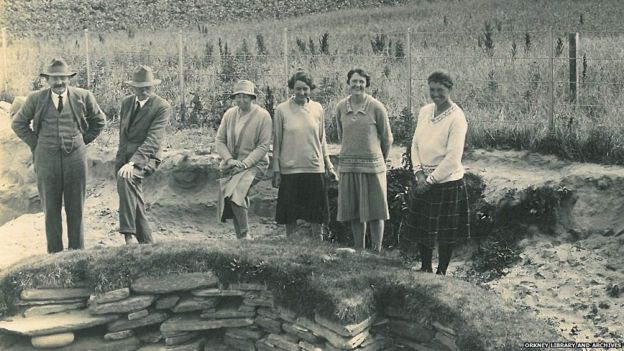Internet Sleuths Were on the Case to Name the Women Archaeologists in These Excavation Photos
A caption in a book about the excavation at Skara Brae, Scotland, had identified them as ‘visitors’ to the dig
/https://tf-cmsv2-smithsonianmag-media.s3.amazonaws.com/filer/36/a5/36a51401-37c0-4f38-a5a6-10eef326cf89/orkey.png)
After an 1850 storm whipped across Orkney, an archipelago off the coast of Scotland, it revealed an archaeological marvel. Strong winds and high tides stripped off the grass that covered a dune known as Skara Brae, exposing the remains of a Neolithic settlement. The site, which consists of eight surviving dwellings connected by covered passages, was investigated shortly thereafter, and revisited by archaeologists in the mid-1920s. As Jessica Leigh Hester reports for Atlas Obscura, several black-and-white photographs taken at an excavation at Skara Brae in the later part of the decade recently came to the attention of internet sleuths, who sought to uncover the identities of several women seen in the images.
The photos, which are held by the Orkney Library and Archive, show men and women standing in and around the prehistoric houses. Clearly identifiable is V. Gordon Childe, the famed archaeologist and University of Edinburgh professor who performed leading excavation work at Skara Brae. But the names of the women with him in the photographs were unknown. A caption in a book about the dig had deemed them “visitors” to the excavation, according to Hester. A note scrawled on the back of a photograph depicting Childe and four women, however, identified the figures as “Prof Childe” and “4 of his lady students.”

There were other clues that the women were not just casual observers. While they are dressed neatly in dresses, sweaters and hats, their shoes are covered in dirt. For Mairi Davies, an archaeologist at Historic Environment Scotland, she tells Hester that she became interested in the photos several years ago, after noticing that a woman in one image is holding a trowel. Last year, an article in Current Archaeology identified her as Margaret Simpson, a pioneering archaeologist who wrote guidebooks to medieval monuments, and is in fact acknowledged in Childe’s writings on Skara Brae, according to the BBC.
But the investigation into the “lady students” really took off earlier this year, when Dan Hicks, a professor of archaeology at Oxford, tweeted the images and asked for help figuring out who they are. At first, Hicks tells the BBC, “people shared the usual interpretations, and indeed the published interpretations, that these women were either tourists who were visiting the site or local women visiting the site on a day trip.” By modern standards, the women do not seem to be dressed for an archaeological dig—then again, nor are the men, who are wearing vests, suits and caps.
Eventually, through collaborative detective work, the three other women seen with Childe in the aforementioned photograph were tentatively identified as Margaret Mitchell, Mary Kennedy and Margaret Cole, reports the BBC, which also notes that Cole was the only one of the four who did not pursue a career in archaeology; instead, she became a politician and crime writer.
For Davies, the photographs—and our assumptions about them—highlight misconceptions about women’s role in the history of archaeology. “Women have always been involved in archaeology,” she tells the BBC, “and not just sitting at desks writing books, but actually out in the field. Surveying. Excavating. Leading excavations, and so on.”
Davies also notes that Childe was known to have women in his classes at the University of Edinburgh.
“In the arts faculty at that time in some years there were actually more female students than male,” she explains. “And his classes reflected that gender balance.”
What’s more, Hicks tells the BBC, revelations about the images give credit to women who have been “written out of the published accounts of the history of archaeology.”
“Realizing their key role in interpretation of archaeological sites, and in the development of archaeology as a discipline,” Hicks adds, “is very important.”